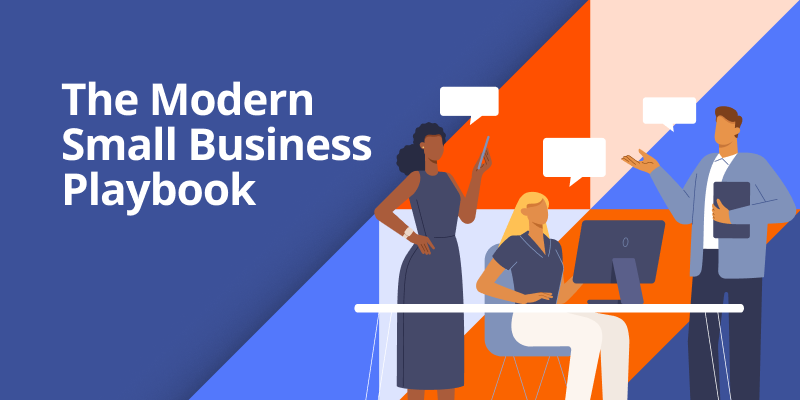When I say “marketing,” what comes to mind? The weight of too many choices and not enough time? Or maybe it’s the sound of dollars flying out of your wallet, never to return?
What if I said you could easily create effective marketing strategies without spending a ton? Or maybe even do it for free? Yes, you can.
Let’s dive into a few ideas that will help you get the most out of your marketing efforts and budget. After all, every hard-working small business deserves a shot at winning more business without breaking the bank.

Free Guide: The Modern Small Business Playbook
DownloadSet the Marketing Budget Before Setting Your Strategy
Cost: Free
It’s easy to dive straight into strategy building, especially when your brain is creatively firing off, but pull back on the reigns. That’s one way to accidentally blow through thousands of dollars.
Budgeting is a critical element of your marketing plan. Before tackling any marketing endeavors, it’s important to establish a well-defined budget.
By understanding your financial constraints, you can allocate your resources accordingly. Consider your budget a roadmap that’s guiding you but also ensuring you make wise spending decisions.
Follow these four steps when building out your marketing budget:
- Identify your marketing short- and long-term goals, setting key items to measure along the way. While your short-term goals may be as simple as increasing your website traffic by 10%, your long-term goal could look like consistently generating 15 new customers every month for a year.
- Hone in on your target audience. Develop five types of customer personalities that you sell to, based on the data you know about your current clients. Send out surveys and chat with customers already doing business with you and those who aren’t locked in yet. Get as specific as you can while creating the personalities for your ideal customers.
- Dig into your market and competition. Market research offers valuable insights into your potential customer base’s demographics and interests. Where do your ideal customers live and what is their average income? What are their wants and needs? What are the issues that could impact them and affect your sales? But also, research which of your competitors are doing well and what marketing strategies are they using.
- Identify the marketing channels you’d like to use. There are four main types: paid, unpaid, digital and traditional. Keep in mind that they will overlap with one another. To get the most bang for your buck, you’ll want to market your business where your buyers go. This is where those customer personalities come into play. While social media is a free and digital channel, if your audience spends their evenings on Facebook, you may consider purchasing ads there to meet your customers where they are.
Expand Your Website with Content
Cost: Budget-friendly
Your website is your digital storefront, and one of the powerful marketing tools that you likely already have but aren’t maximizing on. It’s time to make sure you’re investing in creating quality content that not only gives insight into your many helpful services, but also provides value to the visitor.
Implement regular blog posting on your website to not only drive organic traffic but also establish your business’s authority. Take it one step further. Create nifty how-to guides, informative articles on maintenance or sound off with your opinion on news and trends within your industry.
With AI continuously improving, you no longer have to be a trained copywriter to reap the benefits of a content-filled website. Just be clear about what it is you’d like to discuss when prompting AI to write for you — and if you’re still stuck, ask an AI tool like ChatGPT to generate ideas related to your industry.
Lean into Social Media
Cost: Free to budget-friendly
Leveraging social media is a non-negotiable for small businesses looking to stay within a tight marketing budget. Social media is an affordable way to connect with your audience because you can test organic (unpaid) posts to learn how your audience responds before you purchase ads.
Social media provides a direct line of communication between a business and its target audience. This personalized approach fosters brand loyalty and helps the business to better understand the audience’s ever-changing preferences and adjust its marketing strategy.
Remember: Your customer base is your lifeline, so you need to keep them interested.
Test these 6 ways to make the most of your social media:
- Share customer testimonials. This can be done through posting a video, graphic quote or screenshot of a review to your social pages. If you can, tag the customer in the post so they’re more likely to share the post, which boosts your engagement.
- Run contests or giveaways. Everyone enjoys a freebie, so make these as grand or humble as you want. Use this as an opportunity to increase your reach by requiring contest participants to follow your social pages and tag two friends.
- Create engaging content. If you have an industry hack, now’s the time to pull it out, impress some viewers and earn some shares. Tutorials and before-and-afters are also share-worthy pieces of content that will land you visibility and perhaps several new customers.
- Share behind-the-scenes footage. Sometimes the greatest things are the simplest. If pool cleaning can be considered an autonomous sensory meridian response, or ASMR, why not post a video of you skimming leaves out of the water? We’re naturally curious people, so show your followers what a day in your shoes looks like.
- Host live Q&A sessions. This is an excellent way to further establish yourself as a leader within your industry. By allowing others to hop on your live video, you’re able to showcase your knowledge but also connect with your customers.
- Use relevant hashtags. We’ve been using hashtags for a while; however, the use of them has transformed. Users no longer have to seek out specific hashtags. Instead, social media platforms take notice of the hashtags and use them in tandem with their algorithm to route your content to the users who would find interest or have previously searched for the topic.
Maximize Email Marketing
Cost: Free to budget-friendly
Before you jump past this section, don’t underestimate the power of a well-structured email marketing campaign. While email may seem dated compared to social media, it’s one of the most cost-effective ways to nurture your leads and retain your customers.
With minimal overhead costs, you’re able to reach a wide audience at a fraction of the cost of traditional ads, billboards and mailers. By segmenting email lists, businesses can better target these messages and increase their chance of landing a new client. Be sure to use enticing subject lines. If your email isn’t opened, it won’t matter what’s on the inside.

Modern Small
Business Playbook
Modernize your business, get paid faster and win more customers.
Become Your Own PR Professional
Cost: Free to budget-friendly
Who needs a major marketing budget for public relations when you can seek out opportunities for yourself? Social media and email are great but sometimes a more hands-on approach can score your small business big points.
- Reach out to local media outlets to pitch an on-air segment on a morning show
- Guest blog for a publication within your industry
- Stop by a podcast and lend your expertise and opinion
- Commission a street artist to create an eye-catching mural that incorporates your brand
- Participate in a niche, quirky or community event that aligns with either your business or its mission
Collaborate with Other Businesses
Cost: Free to budget-friendly
Two heads are better than one, and the same is true for businesses. Working together benefits everyone in this case. When seeking out a business to partner with, look for one that’s not a competitor but shares a similar target audience.
Through collaborative events, giveaways and cross-promotions, you can organically expand your reach while tapping into one another’s current customer base.
A great example of this concept at work is auto manufacturer BMW and designer Louis Vuitton’s The Art of Travel campaign. When you consider Louis Vuitton’s signature luggage lines, both brands are in the business of travel, value luxury and are known for their high quality.
The two brands successfully gained the attention of their loyal customers by selling complementary high-quality products that cater to their target market’s desire for luxury and thorough craftsmanship. You can do the same.
Consider these pairings that could make for a successful collaboration.
- Fitness center and a dietitian
- Event planning and decor services
- Travel agencies and boutique hotels
- Artist and a coffee shop
- Pet groomer and dog trainer
Repurpose Your Content
Cost: Free to budget-friendly
If you put the time into a blog, get more mileage out of it. Efficiency is key when it comes to small business marketing. Turn that blog into a checklist and flip that how-to video into an infographic.
Create a graphic for a new blog and share it on various platforms, including the link so they can easily access the piece. While you’re at it, take inventory of those historic social posts that have performed well. Can you reshare or update them?
The goal: Touch every piece of content more than once. When you recycle your content, you save yourself time and resources, in turn saving your business some green. But it’s not just a means of maximizing your resources. It also allows a business to maintain consistent and valuable engagement with its audience during a time when consistency and quality are paramount.
Revisit Your Marketing Tools
Cost: Budget-friendly
How often are you revisiting your marketing solutions? It starts with a couple of $20 software programs and before you know it, you’re spending hundreds of dollars monthly — and still floundering.
Yes, technology makes life simpler; however, it can get out of hand. Consolidate these tech tools when possible to avoid unnecessary spending and find software that takes care of your needs from start to finish, like Thryv Marketing Center℠— the one-stop shop for promoting small businesses.
This marketing software makes it simple to:
- Run, organize and manage ad campaigns
- Boost your online presence
- Understand your audience
- Make data-driven decisions
Invest in Yourself
Cost: Budget-friendly to expensive
While free, organic efforts are important to stay within your marketing budget, allocating a portion of your budget to paid media can lead to a major payout.
If you notice a post on social media has a lot of likes, comments and shares, and it’s bringing in more customers, that’s the ideal time to put some money behind it.
Experiment with paid ads on social media platforms, search engines or through ad networks. Just be mindful of your bids and daily caps, and monitor your performance so you can continuously adjust your bidding strategy to benefit the business.
Making the most of your marketing budget is one skill that can significantly impact the success of your business. Remember, it’s not about the size of your budget but rather how wisely you allocate resources to make the budget work for you. With these strategies in place, your business is on the way to thriving in a competitive market.

Free Guide: The Modern Small Business Playbook
Download







